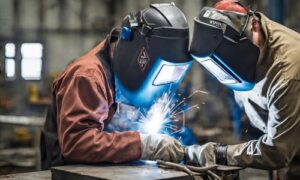Table of Contents
Wearing a welding cap isn’t just about protection; it’s a craft that ensures safety and comfort during intense work. Understanding the nuances of choosing, wearing, and maintaining your welding cap can significantly impact your welding experience.
From historical significance to practical tips, this guide is a blueprint to elevate your welding game and ensure your safety on the job. Dive in to discover the secrets of a well-worn welding cap. In this article, we will provide you with a comprehensive guide on how to wear a welding cap effectively and comfortably.
1. How to Wear a Welding Cap
-
Recognizing the Importance
It’s not just the tools that make welding possible; it’s also the gear. A welding hat might look like a small addition, but it is an important part of making sure workers are safe and comfortable.
Its significance lies in shielding against sparks, heat, and potential burns, offering a protective layer between you and the hazards of welding.
-
Historical Context of Welder’s Cap
The evolution of the welding cap holds a unique story. From its humble beginnings as a functional piece of protective gear to becoming a symbol of the welding profession, its journey reflects the merging of practicality and identity within the welding community. Understanding its historical roots can deepen our appreciation for this essential piece of equipment.
Welding caps have evolved not only in design but also in the materials used, offering various styles and functionalities. Exploring this history sheds light on how far this gear has come and how it continues to play a vital role in welding practices today.
2. Choosing the Right Cap
-
Selecting the Proper Size and Material
The right welding cap is more than just a fit; it’s about finding the optimal size and material for your work environment. Consider the circumference and depth to ensure a snug yet comfortable fit. Additionally, choosing the right material is crucial. Cotton, denim, or leather—each material offers different levels of protection and breathability. Understanding your working conditions will guide you towards the most suitable choice.
-
Considering Cap Color and Style
While functionality is key, your welding cap can also reflect your personal style. Opt for colors that don’t compromise safety but allow you to stand out or blend in according to your preference. Some caps come with patterns or designs that add a touch of individuality without compromising safety standards. Balancing style with functionality ensures you stay protected while expressing your personality.
A welding cap isn’t just about protection; it’s an extension of your work persona. Choosing the right size, material, color, and style will not only enhance your safety but also contribute to your comfort and confidence during welding tasks.
3. Proper Placement and Adjustment
- Techniques for Secure Fit
Ensuring a secure fit is paramount when wearing a welding cap. Proper placement on the head is essential for maximum protection. The cap should cover the crown and ears adequately without obstructing your vision or movement. Adjusting the cap to sit comfortably without being too loose or tight is crucial to prevent any discomfort or distractions while working.
- Adjusting the Elastic Band and Ear Flaps
The elastic band plays a pivotal role in maintaining the cap’s position. Adjust it snugly to keep the cap in place throughout your work. Also, fixing the ear flaps is necessary; they should completely enclose the ears to provide an additional layer of defense against sparks and other projectiles. Determining the ideal balance between comfort and safety is crucial.
- Ideal Angle for the Cap
The angle at which you wear your welding cap can impact both visibility and protection. Tilt it slightly to shield your face while maintaining a clear line of sight. Finding the optimum angle might take some adjustment, but it significantly contributes to your comfort and safety during welding tasks.
Mastering the art of placing and adjusting your welding cap ensures not just protection but also comfort and ease of movement while you work. Paying attention to these details elevates your overall welding experience.
4. Ensuring Comfort and Safety
- Maintaining Visibility
Visibility is crucial when working with precision in welding. Ensure that your welding cap doesn’t obstruct your line of sight. Adjust the cap or your headgear to maintain a clear view of your workspace, enhancing accuracy and safety.
- Compatibility with Welding Mask
Your welding cap should complement your welding mask for optimal protection. Ensure they work in tandem without hindering each other’s functionality. This compatibility ensures complete coverage while allowing flexibility and ease of movement.
- Comfort and Flexibility Factors
Apart from protection, comfort plays a pivotal role in prolonged welding sessions. A well-fitted cap that doesn’t cause discomfort or restrict movement allows you to focus entirely on your work. Look for flexibility in the material and design, enabling you to maneuver comfortably without compromising safety.
Prioritizing visibility, ensuring compatibility with other safety gear, and emphasizing comfort and flexibility in your welding cap choice significantly contribute to a safe and comfortable welding experience. These factors collectively enhance your efficiency and precision in welding tasks.
5. Step-by-Step Guide to Wearing a Welding Cap
Now that you have your welding cap and have prepared for the welding task, follow these steps to wear it correctly:
- Putting on the Cap
Place the welding cap on your head, ensuring the crown covers your entire head comfortably.
- Adjusting for Comfort
Adjust the cap’s fit to ensure it sits snugly on your head without causing any discomfort.
- Securing the Chin Straps
Fasten the chin straps securely to keep the cap in place. This step is essential to prevent the cap from falling off during welding.
- Ensuring Proper Protection
A well-worn welding cap should provide adequate protection from various welding hazards. Here are some additional tips to ensure proper protection:
- Covering the Neck and Ears
Ensure that the flaps of the welding cap cover your ears and the back of your neck. These areas are susceptible to sparks and heat, and the cap’s flaps will shield them effectively.
- Avoiding Loose Ends
Make sure there are no loose ends or flaps hanging from the cap, as they may accidentally come into contact with the welding equipment.
5. Maintenance and Care
- Cleaning and Upkeep of the Cap
Regular cleaning prolongs the life of your welding cap. Follow manufacturer guidelines for cleaning methods, whether it’s machine washing or hand washing. Proper maintenance not only keeps the cap looking good but also ensures its protective qualities remain intact.
- Preserving Cap and Helmet Lens
Protective gear, including the welding cap and helmet lens, requires regular inspection and upkeep. Keep the cap away from harsh chemicals and extreme temperatures to maintain its integrity. Similarly, regularly check and clean the helmet lens to ensure clear vision and safety while working.
- Long-Term Cap Care Techniques
Beyond cleaning, consider long-term care practices for your welding cap. To make it last longer, keep it in a cool, dry place when not in use. To keep things safe, check the cap every so often for damage or wear, and replace it if necessary.
By consistently cleaning and maintaining your welding cap, along with paying attention to other safety gear like the helmet lens, you ensure their longevity and effectiveness in safeguarding you during welding tasks. These simple yet crucial practices preserve their protective qualities, contributing to a safer work environment.
6. Bonus Tips for Style and Coolness
- Enhancing Appearance with the Cap
Your welding cap isn’t just functional; it’s an opportunity to showcase your personal style. Experiment with different colors, patterns, or designs that resonate with your personality. While safety remains paramount, expressing yourself through your welding cap can add a touch of individuality to your work attire.
- Adding Personal Style
Consider accessorizing your welding gear to reflect your unique style. Whether it’s adding a personal emblem or customizing the cap, small touches can make a significant difference in expressing yourself while adhering to safety standards.
- Tips for a Stylish Welding Experience
Beyond the functional aspect, feeling good about what you wear can boost confidence. A comfortable and stylish welding cap not only protects you but also contributes to a positive mindset while tackling welding tasks. Embrace your style while ensuring safety—it’s a win-win.
Incorporating elements of style and personal flair into your welding attire not only allows you to express yourself but also adds a sense of individuality to your work. Balancing safety with style enhances your overall welding experience, making it both safe and enjoyable.
Conclusion
In conclusion, wearing a welding cap isn’t merely about safety—it’s a fusion of functionality, style, and care. Understanding its historical significance, selecting the right fit and material, and mastering its proper placement and maintenance are essential elements in elevating your welding experience.
By prioritizing safety without compromising individuality, maintaining gear regularly, and embracing personal style, you not only ensure your safety but also enhance comfort and confidence during welding tasks. Remember, a well-worn welding cap isn’t just a shield; it’s a reflection of your dedication to safety and craftsmanship in the welding profession.
FAQs about How to Wear a Welding Cap
Do welding caps come in different sizes?
Yes, welding caps typically come in various sizes to accommodate different head sizes and shapes.
Can I wash my welding cap in a washing machine?
Some welding caps are machine washable, but always check the manufacturer’s instructions to ensure proper care.
Are all welding caps fire-resistant?
Welding caps are designed to be fire-resistant, but the level of resistance may vary based on the material. It’s essential to check the cap’s specifications.
Can I wear a welding cap with other headgear?
It’s not advisable to layer welding caps with other headgear, as it might compromise their effectiveness and fit.
How often should I replace my welding cap?
The frequency of replacement depends on usage and wear. Inspect your cap regularly for signs of damage and replace it when needed.



1 thought on “How to Wear a Welding Cap: A Complete Guide”